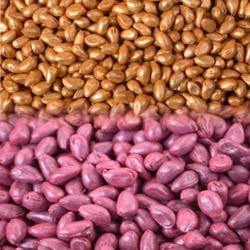13
Dec
Report Finds EPA “Sugarcoating” Effects of Hazardous Neonic Seed Coatings
(Beyond Pesticides, December 13, 2016) Net Loss, a new report released by the Center for Food Safety (CFS), indicates the use of neonicotinoid-coated seeds is exactly that, an economic drain for farmers that only results in the indiscriminate poisoning for non-target wildlife, such as pollinators. The report is a follow up to a 2014 report, Heavy Costs: Weighing the Value of Neonicotinoid Insecticides in Agriculture, which concluded that neonic seeds bring greater costs than benefits to farmers. Later that year, a study published by the U.S. Environmental Protection Agency (EPA), which looks specifically at the economic value of neonic coated soybeans, made similar determinations —insecticide seed coating provide little or no overall benefit in controlling insects or improving yield or quality.
CFS’s new report cites numerous new studies published over the past several years that reinforce the group’s original determination on the realized benefits pesticide-coated seeds provide to farmers. Front and center in the report are preliminary results from the European Union’s suspension on the use of neonics on certain agricultural crops. The report finds that after the 2013 EU moratorium, despite cries from the agrichemical industry of rampant crop failures, yields actually increased. For maize, the EU saw a 5.7% rise, and oilseed rape (canola) witnessed a 14.4% increase in yields. Much like the hype of genetically engineered crops’ value, which a recent New York Times article showed to hold up poorly to scrutiny, it appears the agrichemical industry has again sold American farmers a bill of goods. Indeed, in every cropping system investigated by CFS, crop yields showed negative, negligible or inconsistent differences based on whether or not a crop seed was coated with neonicotinoid insecticides.
While the benefits to farmers are insignificant, the harm neonicotinoids cause to the wider environment is of serious concern. The dust kicked from planting coated seeds can drift off-field and contaminate field margins with high levels of these toxic pesticides. Indeed, the report cites findings that, depending on the crop, only five percent of the active chemical in a seed coating actually enters a crop. The other 95% of the chemical makes its way into the environment, either through seed dust, soil contamination, or water runoff. Just last month, Health Canada announced it would ban applications of the most widely used neonicotinoid, imidacloprid, as a result of dangers to aquatic life near agricultural fields. Neonics have been widely implicated as the most significant factor impacting the decline of pollinators around the globe. Effects range from acute toxicity and death, to chronic impacts such decreased memory and learning, inability for bees workers to find their way back to the hive, decreased queen fertility, and overall increased susceptibility of the colony to viruses, disease, and parasites.
Certain U.S. states are beginning to consider action to restrict the use of coated seeds. The state of Connecticut recently required the development of best management practices to avoid pesticide drift from dust kicked up during seed planting. And in Minnesota, where a recent executive order from Governor Dayton requires proof of a pest emergency before spraying foliar neonicotinoid applications, the Governor and Minnesota Department of Agriculture (MDA) also recommended legislation to give MDA the authority to regulate coated seeds. This was necessary because in the U.S., coated seeds are considered exempt articles under federal pesticide law (the federal fungicide insecticide and rodenticide act, or FIFRA). As such, they are not subject to the same protocols and regulations governing pesticide use. A recent lawsuit from CFS challenges this loophole in pesticide law, but a decision handed down late last month affirmed the exemption, indicating that, “The Court is most sympathetic to the plight of our bee population and beekeepers. Perhaps the EPA should have done more to protect them”¦” Thus, as EPA has so far showed its unwillingness to act to help bees and beekeepers, it is up to states and local governments to push for common-sense restrictions on these toxic products. The more local governments act, the more pressure it puts on EPA and the federal government to adequately address this crisis. After over a decade of year-after-year historic declines, it is only a matter of time before the true Net Loss of this crisis is revealed.
If you’re interested in doing more to become active in your community to stop and reverse pollinator declines, see Beyond Pesticides’ Bee Protective program page. Become educated on the science, and start your advocacy efforts by contacting Beyond Pesticides at 202-543-5450 or [email protected].
Source: Center for Food Safety
All unattributed positions and opinions in this piece are those of Beyond Pesticides.










